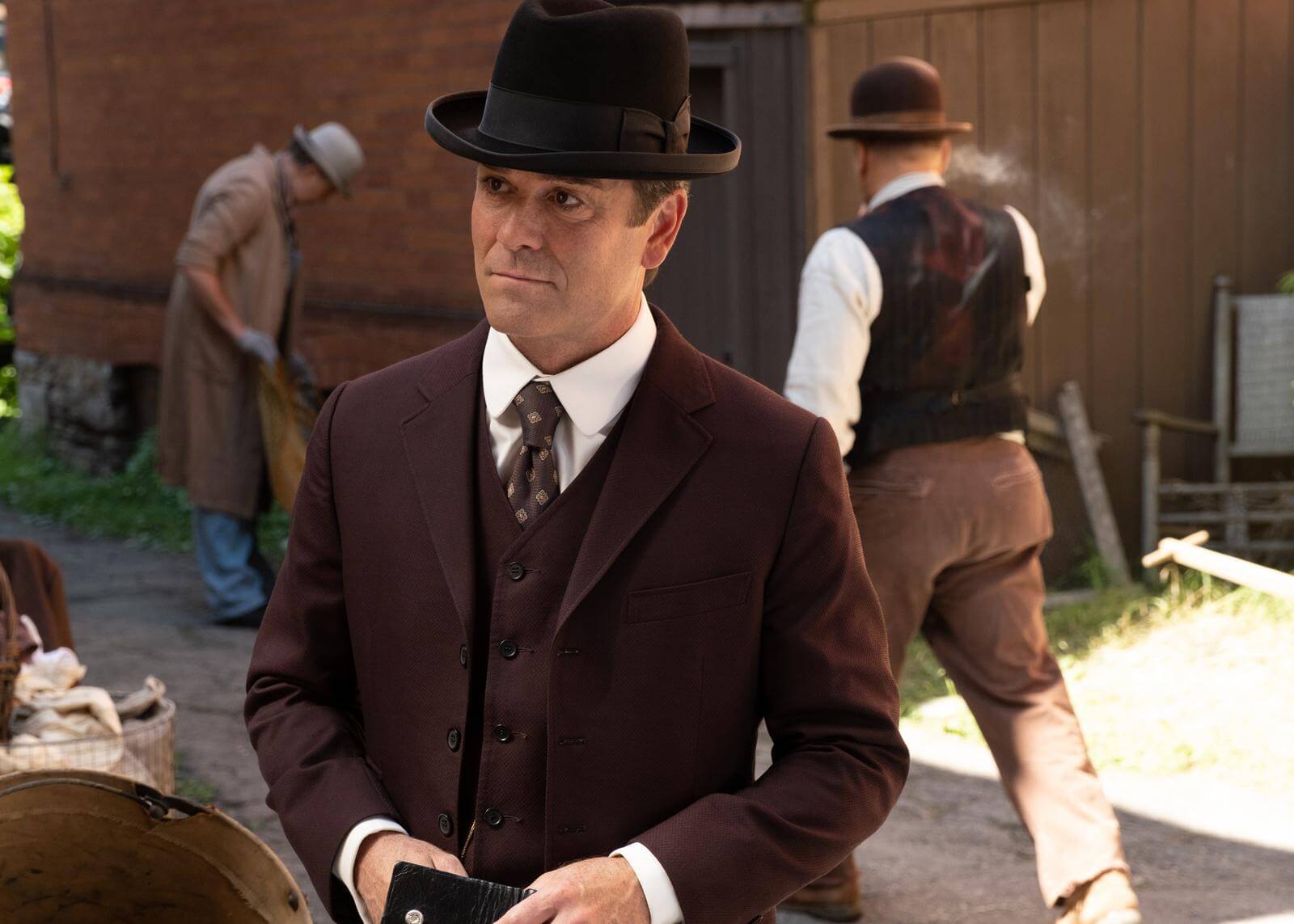S18 E4 – Gimme Shelter
Toronto The Good No More

Spoiler Warning: Do not read on if you haven't watched this episode!!
Murdoch Mysteries shines brightest when it focuses on a central theme that engages all its main characters. Gimme Shelter does just that, deftly weaving a murder mystery with poignant social commentary on the injustices of early 20th-century Toronto. It is deeply ironic and, perhaps surprisingly, it’s also very funny!
The episode revolves around the murder of Miss Mysha Boyko (Bianca Rusu), whose death in a newly opened apartment building initially appears to be an overdose but is later revealed to be a case of strangulation. The investigation unfolds with Detective Murdoch (Yannick Bisson), Inspector Choi (Paul Sun-Hyung Lee), and Detective Watts (Daniel Maslany) collaborating to piece together the clues. The narrative is methodically structured, with each clue leading seamlessly to the next, showcasing solid police work—though it does start with a missed clue.
Echoes of Today
Over the years, Murdoch Mysteries has tackled many social issues: racism, sexism, poverty, addiction, housing shortages, xenophobia, class disparity, and more. This episode ties all these themes together through the lens of low-income housing. Toronto is developing with all the social unrest that comes with it. I’m not sure if Toronto the Good ever existed, but it certainly doesn’t exist anymore in 1912. The show’s handling of these issues feels particularly relevant today, with discussions around gentrification and the NIMBY (Not in My Backyard) mentality echoing current urban dilemmas. The characters’ discussions about the challenges of affordable housing and the attitudes towards immigrants echo contemporary debates, suggesting that despite societal progress, many issues remain unresolved.
Prejudice
Gimme Shelter is particularly strong because it uses the main cast to tell a multifaceted tale of social injustice. Everyone harbors some degree of prejudice, even as they may also find themselves on the receiving end of it.
Inspector Choi encounters some pretty overt racism and has no patience for white-collar frauds. Chief Constable Brackenreid (Thomas Craig), who used to side with the underdog, has now become something of a NIMBY. Thankfully, he is made to reconsider his stance by his wife Margaret (Arwen Humphreys), and Effie Crabtree (Clare McConnell) – as well as the actions of a fraudster who is preying on the hypocrisy of those who advocate for community improvement while resisting changes that might affect their own comforts.
The murderer, Mrs. Robinson (Juno Rinaldi), embodies a do-gooder mentality, believing she is morally superior because of her charitable work. Ironically, her actions—committing murder to maintain her neighborhood’s “purity”—contradict her self-image as a benefactor. The victim, although a recovering cocaine user, was trying to report wrongdoing and help others; yet her life was cut short by someone who professed to be helping the community. Like Watts said: If Mrs. Robinson hadn’t been so blinded by fury and prejudice, Miss Boyko might still be alive.
Even Murdoch isn’t above (reverse) prejudice. Would he have been more suspicious if the murderer weren’t a Catholic and a charity worker? He missed a vital clue at the beginning of the investigation when Mrs. Robinson referred to the victim as her.
Character Development
The episode excels in character development, revealing new layers even in long-established figures. Margaret, in particular, shines as she challenges her initial prejudices, showcasing growth and open-mindedness. Meanwhile, Murdoch’s internal struggles regarding his assumptions about the murderer add a layer of complexity to his character, inviting viewers to ponder the impact of bias on judgment.
We also learn more about the new(ish) characters. Llewellyn Watts has been around since Season 10, but there is still a lot we don’t know about his background. Through his childhood friend, Olivia Leeming (Tommie-Amber Pirie), we get a glimpse into his soul. Apparently, he’s always been scrawny and awkward, and not much of a fan of authority. He also gets obsessed. Through Watts’s interaction with Olivia, we see that he, who has been searching for something most of the time we’ve known him, has found a home with the Constabulary. He feels accepted there. This is reinforced by small details in the writing—his plants—and the acting: Murdoch hardly rolls his eyes anymore at Watts’s antics and even turns the tables somewhat by fiddling with Watts’s plants. Still, Olivia’s painting of him seems to suggest there’s hidden depths that haven’t been explored yet.
Meanwhile, Station House 4’s newest recruit, Inspector Choi, is also fleshed out as a character. So far, we’ve seen him as an easygoing and empathetic man. He appears stoic in the face of the racism he encounters but is not above getting even when given the chance. He can definitely play the bad cop in the good cop/bad cop routine and is more than prepared to not do things by the book.
Humour Amidst Darkness
Despite its serious themes, “Gimme Shelter” is infused with humour. Choi’s antics with the stolen plants made me chuckle at first and laugh out loud by the time he took the orchid. Yet the highlight of the episode was Murdoch, ever-so-deadpan, catching two suspects using a clothesline full of laundry. This scene stood out even in an episode that was already well-written, well-directed, well-acted, and well-edited.
Bits and Bobs
This Episode's Hat:



